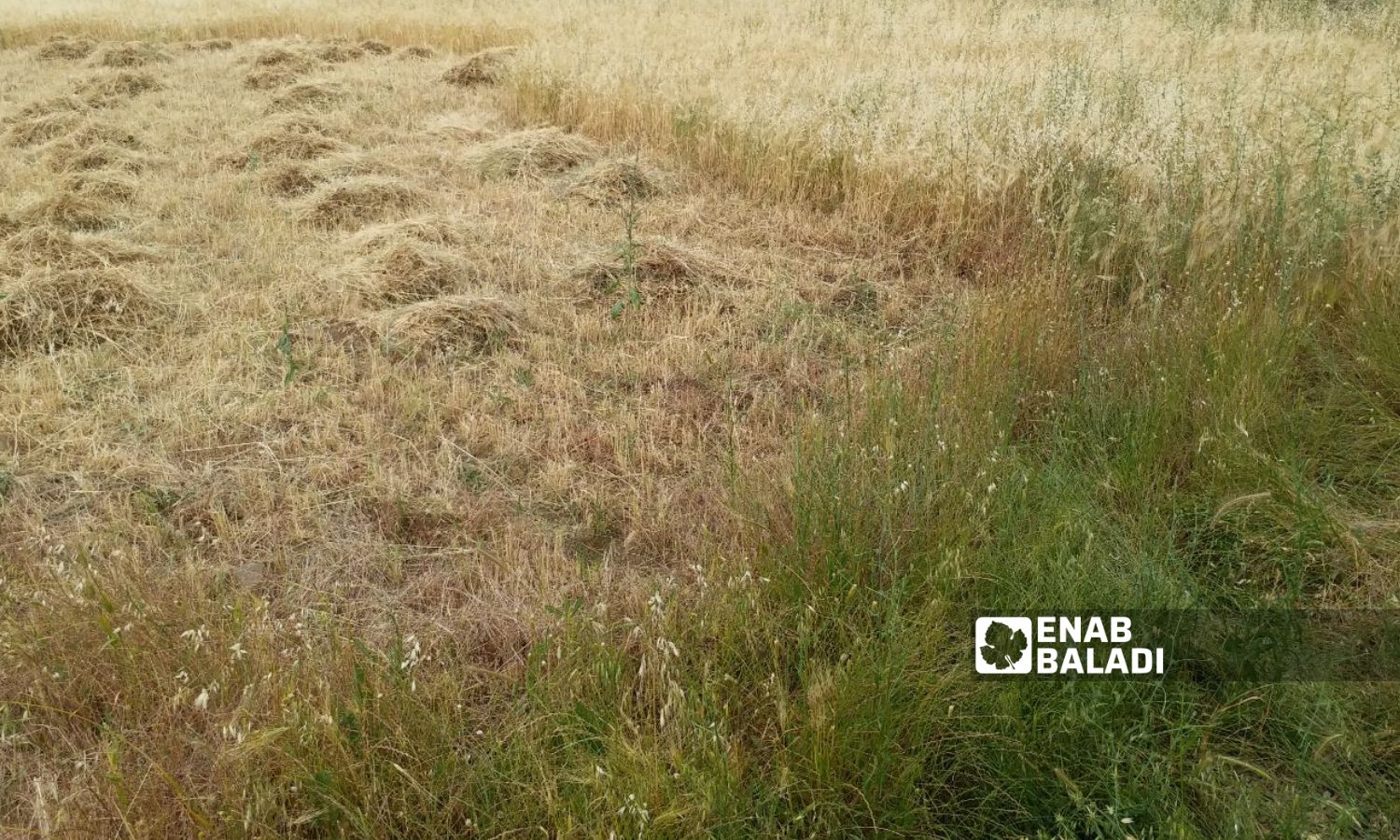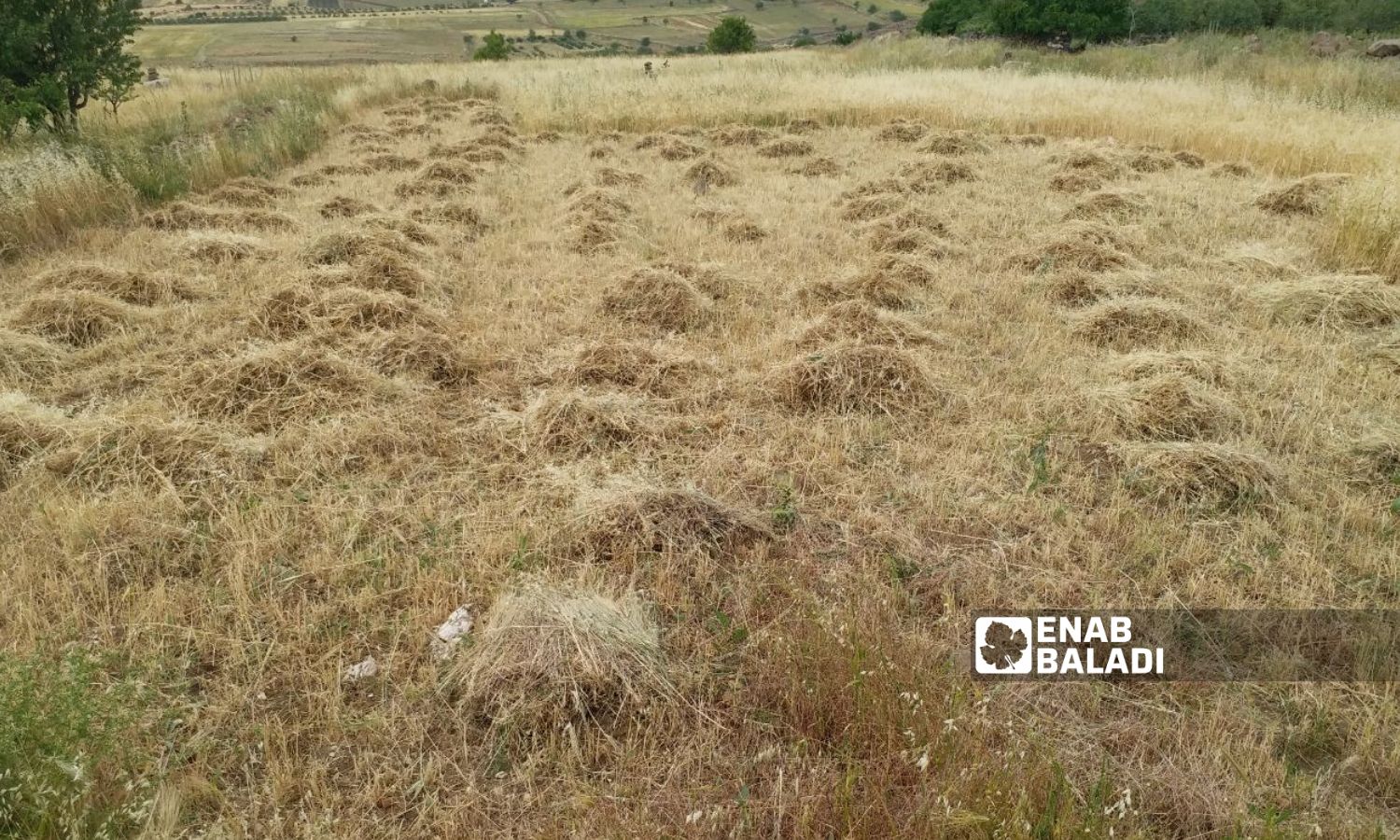



Quneitra – Zain al-Jolani
Hassan Mohammad complains about the high wages of workers during the harvest season on his 50 dunams in the northern countryside of Quneitra governorate, which is cultivated with wheat, barley, lentils, chickpeas, and vetch.
The farmer told Enab Baladi that he pays half of what his crop produces as the wages of harvest workers this year, as the wages for harvesting a dunam ranged from 85,000 to 100,000 Syrian pounds.
He added that the value of what he will pay as a harvest fee only for his entire land amounts to five million Syrian pounds, and this is the case for most farmers in the area, which has a mountainous and rugged nature, which is difficult for modern harvesters to enter.
In addition to the costs of the harvest fare, the fee for plowing the land previously, and the fare for transporting and crushing the crop at a later time, shall be added.
In the event that the harvesters enter some or part of the land, the fee for harvesting a dunam is about 40,000 Syrian pounds, which is acceptable and equal to half of what the farmer pays to the workers.
A number of farmers resort to not bringing workers or a harvester, relying on a number of family members, and the costs are limited to bringing a tractor to transport the crop and rent for sorting grain from the chaff.
The farmer pays 50,000 Syrian pounds to the owner of the tractor for transportation and 75,000 for the threshing machine.

A land planted with wheat in the eastern countryside of Quneitra governorate – June 3, 2023 (Enab Baladi/Zain al-Jolani)
At a time when farmers complain about high labor wages, the harvest season represents an opportunity for some workers to make money to secure the needs of their families.
Ayman al-Mahmoud, who has been married for about a year and has been summoned to perform compulsory military service, resorted to work during the harvest season this year in the northern countryside of Quneitra to meet the needs of his family.
Al-Mahmoud told Enab Baladi that he goes out to work in the morning and returns in the afternoon to rest for a few hours, and then continues his “hard” work in the afternoon. He harvests about half a dunam of wheat or barley every day and gets an amount of 50,000 Syrian pounds.
This wage covers al-Mahmoud’s daily needs without any money left. Sometimes it is sufficient to buy lunch in light of the high prices and the poor and deteriorating living and economic situation in the region and in Syria in general, he said.
Salim Mohammad, a young man who works with his mother and siblings on his five dunams of wheat-cultivated land, says that a farmer who does not work with his own hands will not be able to save any money and may sometimes lose.
Mohammad explained that the wages for reapers reach 100,000 SYP per dunam, and the mechanized harvest ranges from 40,000 to 60,000 SYP, which is expensive for the farmer.
The wages of automatic harvesters vary from one governorate to another in the areas controlled by the regime and have increased by 15 percent compared to last season, according to what the head of the Agricultural Affairs Office in the General Union of Peasants, Mohammad al-Khlaif, told the local newspaper, al-Watan.
Al-Khlaif talked about the lack of complete satisfaction among the farmers in the governorates with the price set by the government of the regime to receive the wheat crop, which is 2,800 SYP per kilo.
He pointed out that they expected the price to be more than that and that the cost of a kilo of wheat for the farmer was around 2,400 pounds.
On the 18th of last April, the government of the regime set the price of purchasing a kilo of wheat from farmers at 2,300 Syrian pounds ($0.3), describing the price as “encouraging” despite the fact that its value was less than what it set in 2022 ($0.5), and it was then equivalent to 2,000 SYP.
The economic committee in the regime government raised the purchase price of the substance about three weeks after the first decision and set the price per kilogram at 2,500 SYP.
An amount of 300 SYP is added to it as “encouraging incentives,” bringing the final price to 2,800 SYP per kilo after sharp criticism that the price is not commensurate with the costs.
Most farmers still consider that the price does not reach the minimum farming expenses, amid a 100% increase in harvest costs this year, in addition to the high production costs of securing seeds, fuel, water, and others.
The government newspaper al-Thawra said on May 23 that the Quneitra governorate has designated two centers to receive wheat from farmers in the towns of Khan Arnabeh and Sweiseh.
Three days a week (Saturday, Tuesday, Thursday) were set for receiving wheat, with the aim of easing the burdens on farmers.
The newspaper stated that the Governor of Quneitra, Moataz Abu al-Nasr Jamran, stressed that every grain of wheat should be received from the farmers and that this should not be tolerated.
Jamran stressed that handing over wheat to other than the centers of the Syrian Grain Corporation is considered a theft of the public right, threatening to impose the most severe penalties in this case and refer it to the judiciary, especially after the governorate secured all agricultural production requirements of fuel, seeds, and fertilizers, according to al-Thawra newspaper.
The Director of Quneitra Agriculture, Engineer Rifaat Mousa, explained to the newspaper that the area of wheat cultivated this year amounted to 38,450 dunams between irrigated and rain-fed land and that the purchase of the wheat crop begins from June 1 until next August.
On May 25, the official Syrian News Agency (SANA) quoted the director of Quneitra Agriculture as saying that the area cultivated with wheat amounted to about 12,150 dunams, without any clarification as to whether the number was rain-fed or irrigated.
if you think the article contain wrong information or you have additional details Send Correction